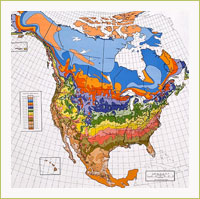
2010 was the first year home gardeners could find Burpee Home Gardens vegetable and herb plants in their local garden retail centers. It’s been an amazing year, filled with lots of information and education, and plenty of opportunities to grow a successful vegetable garden.
Throughout the season, the Burpee Home Gardens team was there to answer your questions and offer solutions to your vegetable obstacles. We’ll highlight a few of our Frequently Asked Questions over the next few months, beginning with this blog on “Hardiness Zones”.
Question: “I see ‘zones’ and ‘hardiness zones’ listed on tags and in plant descriptions. What’s a zone?
Answer: If you see a hardiness zone in a catalog or plant description, chances are it refers to the USDA map. The USDA Hardiness Zone Map divides North America into 11 separate zones. Each zone is 10°F (12°C) warmer (or colder) in an average winter than the adjacent zone.
Knowing your zone is a good starting point and can help you determine what varieties have the best chance of survival in your garden. However, we suggest zone maps be used as a guide and not as writ-in-stone rule. As you work in your garden and understand your climate’s nuances, you’ll find ways to adjust your techniques and planting practices through the season to make sure your plants have the light, warmth (and sometimes cool) they need.
To find your USDA Hardiness Zone, check out this map.
One quick note: In order to offer the best chance for vegetable-growing success, all Burpee Home Gardens plants are carefully selected by local growers for excellent performance in your area. So it’s a good bet that if your local greenhouses can grow it, so can you!
Our team is here to help! Send us your gardening questions and we'll help you find a solution.